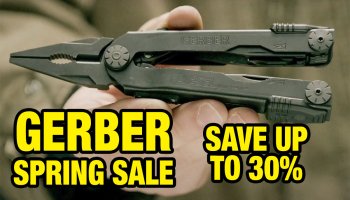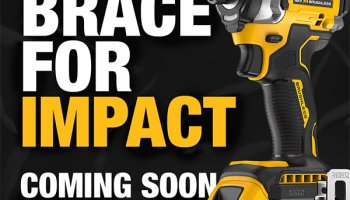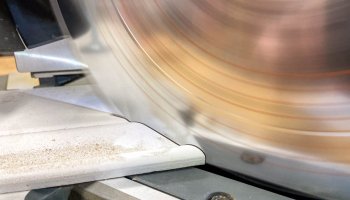
Knowing how to use a drill is like Power Tools 101 – just pull the trigger, right? That’s how a lot of people use this tool, and they do just fine. You can, however, get more out of your tools with a little knowledge. Our Pro readers can skip this article, but for those of you new to cordless tools or just starting out—read on!
The General Process of Using a Cordless Drill
We want to lay out this process in a series of numbered steps, to quickly explain the big picture. After that, we go over the key components of each aspect of the cordless drill that makes up the whole.
Loosen the Chuck
First, loosen the chuck (counterclockwise) so that you can insert the accessory. This might be a twist bit for making a hole in wood or metal, or a driver bit for fastening a screw. You may even need to make a larger hole with a spade bit or hole saw. You only need to loosen it enough for the shaft of the bit to insert into the chuck.
Insert the Bit and Tighten the Chuck
Insert the bit and keep it centered as you tighten the chuck by twisting it clockwise. It’s OK if the bot slides off-center—just loosen the chuck a little to reposition it and continue tightening. Once you have it nice and tight give it an extra twist to make sure you have it fastened as tightly as possible (don’t use a wrench or anything—just hand tighten).
Check Your Mode
Are you planning to work in concrete or brick? If you have a hammer drill, set the tool into that mode. Typically this works via a twisting motion near—or as part of—the clutch settings.
Set Your Clutch
Set your clutch to the proper setting (we cover this in more detail below). These typically feature a “Max” position that bypasses the clutch to give you the maximum amount of power possible from the drill. Use this mode for drilling and use the clutch for driving screws and other fasteners when you don’t want to risk breaking screws.
Position Your Hand and Drill
Hold the drill with your dominant hand and place the other one on top to steady the tool and give you more control. Be careful not to block the vents which help cool the motor while the tool works. For more powerful tools and when drilling into a material (or with a larger bit) that could bind, attach the provided auxiliary handle.
Follow Through
On some applications, you want to use a piece of tape on the bit to make sure you only drill to a certain depth. When going through a stud or similar material, however, follow through once the bit punches through. Then you can pull the bit or hole saw back out and let your finger off the trigger. You’ll find it easier to withdraw a bit while it’s still spinning than trying to pull it out after it stops.
OK, now that you get the general idea, let’s look at some of these key processes and items in more depth so you really understand how to use a drill properly.
You can’t drill or drive anything without a bit, so let’s start with how to use a keyless chuck. Prongs inside compress and eventually come forward out of the chuck as you tighten it down. Counterclockwise rotation tightens it, clockwise loosens it.

Better drills have a ratcheting chuck that grabs hold of the bit and then lets you click over a bit more for extra security. If your tool lacks a ratcheting chuck, you can still get it tight enough to hold bits, but those chucks typically come with models targeted towards the occasional home user.
You’ll see a lot of Pros hold the chuck and bit in one hand and pull the trigger to tighten or loosen the chuck. It works great, just be careful that you feather the trigger so you don’t hurt your hand.
Feathering the Trigger – More Than On and Off
Now that you have a bit in the chuck, you’re ready to start! Most cordless drills have a variable-speed trigger. As you pull the trigger further, the speed increases.

By feathering the trigger (just pulling it slightly), you can drive or drill with what’s called a soft start. It just means starting slowly so your hole or screw is starting accurately before ramping up to full speed.
Using the Gear Selector
Some drills have two, three, or even four different gears to choose from. The relationship between speed and power is inverse – you have less torque at high speed and more torque at low speed.

For driving smaller screws or making smaller holes, you’re good to go at high speed. As you make larger holes with spade bits, hole saws, or self-feed bits or drive large lags, you’ll need to drop into low speed with larger diameters.
The clutch is probably the most underused feature on a drill. You’ll find the clutch settings on the collar behind the chuck and it’s helpful for driving a lot of the same size screws into the same kind of material.

Essentially, you set the clutch to where your fastener is exactly flush or slightly sunk when the drill stops. You’ll be able to get consistent results without thinking too hard about it as you go. Check out our article for more details.
Twist all the way to the end of the collar and you’ll see a drill icon. This bypasses the chuck and is the mode you want to be in for all drilling applications.
Well, almost. There are a couple of exceptions.
Hammer drills have an additional hammer function you can use that’s usually one click past that last mode. You can tell by the hammer icon. This adds a forward “chipping” action to help you drill more quickly in concrete, masonry, or rock. You should never use this mode in metal, wood, and plastics. Check out our hammer drill vs drill article for more information on how this works.
The Makita hybrid impact driver/drill driver doesn’t have clutch settings at all, but it does let you switch between driver, drill, hammer drill, and impact driver modes. The power settings are on the electronic controls below the trigger.
A Note on Batteries
If you’re using a lithium-ion drill, there’s no battery memory to worry about and no excuse not to charge your battery after you use it every time. It’ll keep you from having to delay a project or stop halfway through and wait for the battery to charge.

Some Safety Tips When Learning How to Use a Drill
You’ve got the basics of how to use a drill and it’s time to make some holes! Here are some tips from our Pro Team to make it easier:
- Wear safety glasses unless you like wood or metal chips in your eyes.
- Get the right bit for the material . (See our best drill bits article for recommendations).
- Make a mark with a pencil or pen where you want to drill/drive, don’t guess.
- Make sure you’re angled straight into the fastener. That keeps the bit completely in contact with the screw so you don’t cam out (spin out and damage the head or bit).
- Feather the trigger for an accurate start.
- Putting a second hand behind the tool helps stabilize it and let you put more downforce into it.
- More powerful cordless tools include an auxiliary handle. Use these for high torque applications so you don’t wrench your wrist/elbow/shoulder.
- In general, drill at High speed in wood and Low speed in metal (yes, there are exceptions!)
- Try not to let the chuck hit the material at the end. It can leave a mark.
Like the tool, we used for the photos? It’s the Makita 12V CXT Brushless Drill/Driver. Have any additional tips or tricks that we missed? If so, please feel free to leave a comment below, and as always, thanks for reading!
Code Embed: Cannot use CODE1 as a global code as it is being used to store 1064 unique pieces of code in 1615 posts






